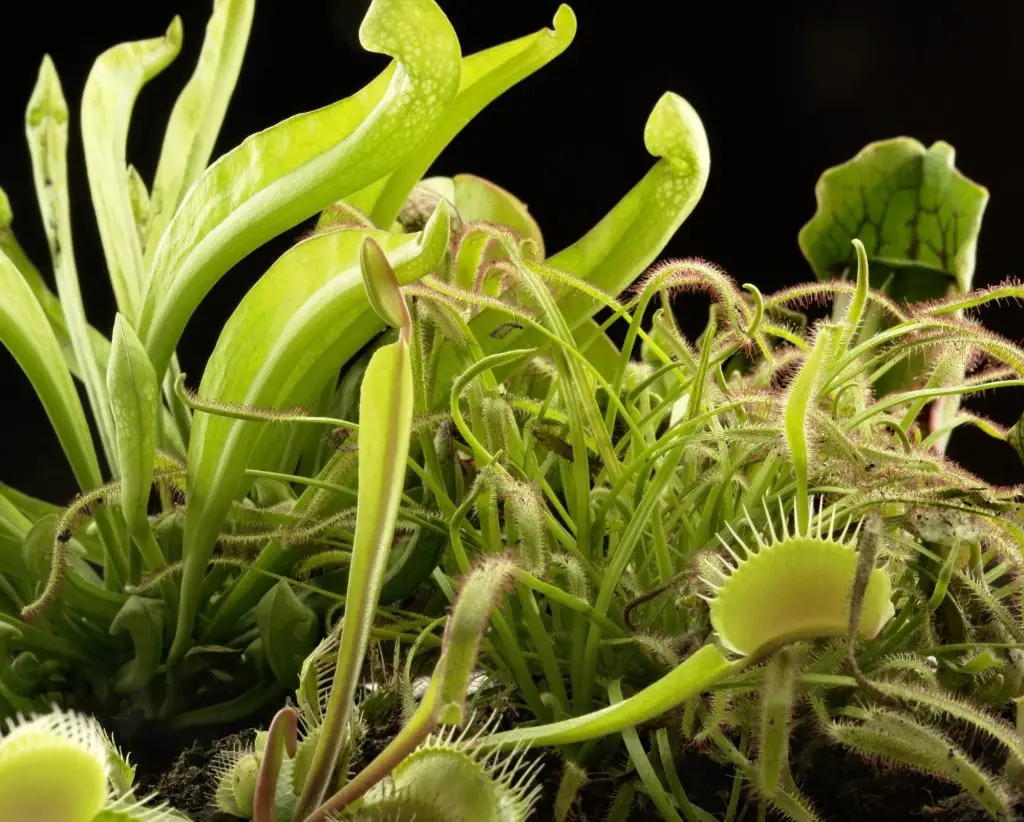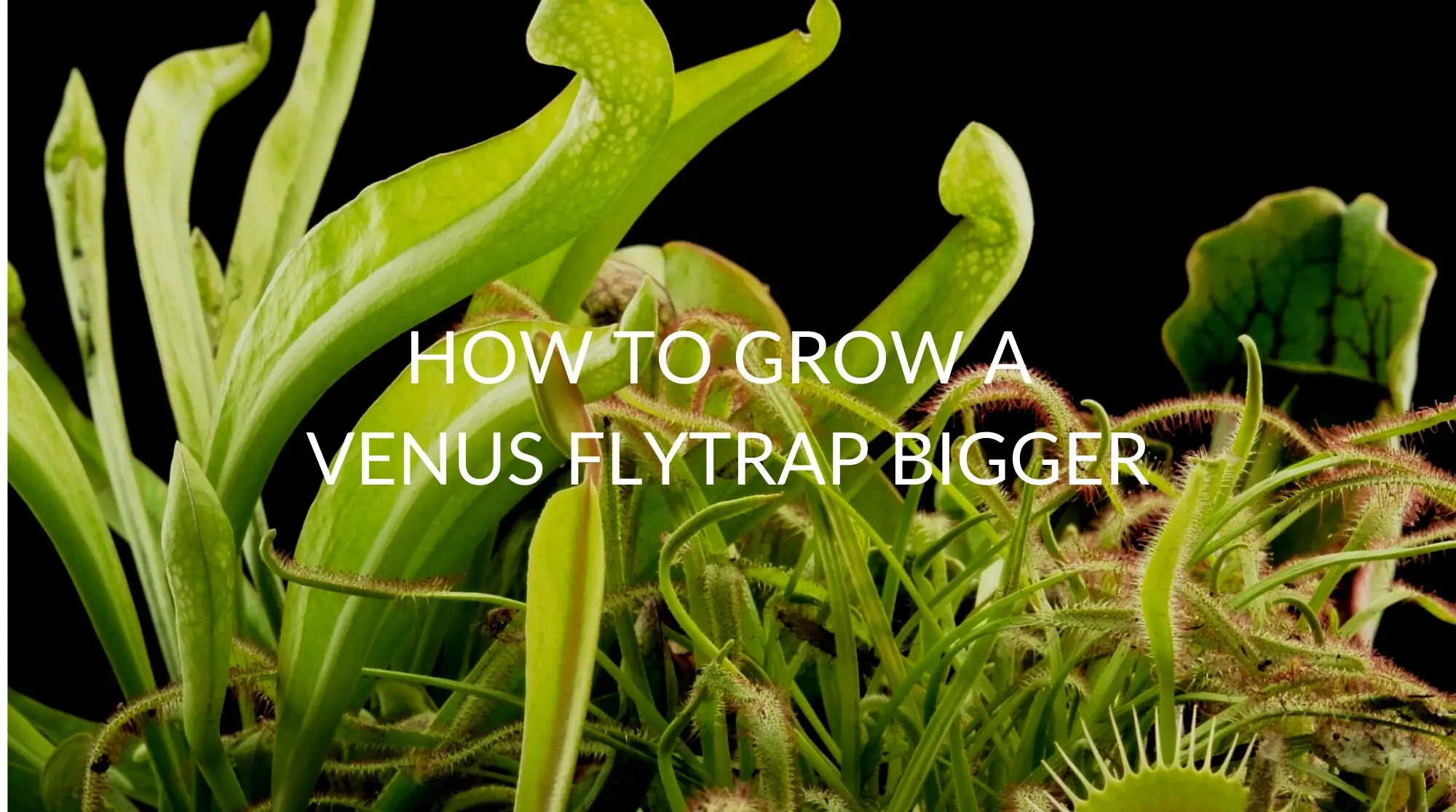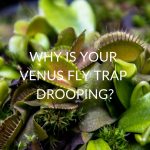If you give your Venus flytrap plant good care and allow it to develop for a few years, it will reach a maximum diameter of roughly 13 cm. It will not, however, expand beyond this size. If given sufficient care, fertilization, and food, a Venus flytrap will produce as many traps as it is capable of.
Continue reading to find out how large Venus flytraps can become, how to grow your Venus flytrap bigger, why your Venus flytrap can be so little, what to feed your Venus flytrap, and other care advice to guarantee your plant can develop to its full potential.
Where Do Venus Flytraps Grow?
Over the years, Venus flytraps have been planted and cultivated worldwide. However, these plants natively only exclusively grow within a 75-mile radius of Wilmington, North Carolina, and a few counties in South Carolina.
These carnivorous plants have become household favorites over time. When keeping a Venus flytrap inside, it is preferable to place it in a south-facing window that receives at least 6 hours of direct sunlight. Alternatively, place the plant under a grow light for 10-12 hours every day throughout the growing season.
Why Is My Venus Flytrap So Small?
You May Not Be Providing Your Venus Flytrap with Adequate Food
If you do not supply enough food for your Venus flytrap, it may remain small. This might indicate that you are not providing enough nutrients to your plant or that you are feeding your trap too much food.
Never feed a Venus flytrap anything larger than a third of the trap’s size. These bigger insects take too long to digest, resulting in the plant not receiving enough nutrients, bacterial decay, and trap death.
You May Not Be Providing Your Venus Flytrap with Adequate Lighting
To be healthy, Venus flytraps require a lot of light, but this light does not have to come from the sun. Venus flying traps can be kept healthy if they are exposed to more than 6 hours of sunshine or artificial lighting every day. If you don’t give your plant adequate light, its size will remain tiny, and it will ultimately rot and die.
You May Not Be Providing Your Venus Flytrap with an Adequate Soil Medium
The Venus flytrap grows best in poor, acidic soil that stays damp but drains well; it should not be put in standard potting soil. The optimal drainage and moisture retention are provided by a combination of one-third sand and two-thirds sphagnum peat moss.
If you do not supply appropriate soil for your Venus flytrap and allow moisture to accumulate, it will not only slow its growth but will also kill it in the long term.
You May Be Overwatering or Underwatering Your Venus Flytrap
Venus flytraps are harmed by both overwatering and underwatering. They have the ability to weaken the plant, keep it tiny, and ultimately destroy it. A Venus flytrap will be severely weakened if it is submerged in water.
This, in turn, will have an impact on the plant’s size. As traps and leaves deteriorate and die, a weak plant will stay the same size or shrink. If your plant looks to be drooping or looking down, it is underwatered.
On the other hand, Venus flytraps can sit in water but should not be left there for long periods of time. As a result, while placing them in a tray of water, the depth of the water should never exceed one inch.

How Big Will My Venus Flytrap Get?
Prepare to be disappointed if you believe that the small malicious plant you recently purchased will grow into a giant monster that will devour your garden’s troublesome starlings.
If you take good care of your plant and keep it for a few years, it will reach a maximum size of roughly 13 cm in diameter. However, that is the size of the entire plant. A single leaf trap can be somewhat longer than 3 cm.
In mediocre circumstances, a plant will have 4 to 8 traps on it at any given moment. However, if you care for your plant properly, it can produce a large number of traps.
How To Grow a Venus Fly Trap Bigger?
Choosing the Right Pot to Promote the Best Growth for Your Venus Flytrap
If the pot or container you pick for your Venus flytrap isn’t large enough, they’ll struggle to develop. A mature Venus flytrap should be kept in a container that is at least 4 to 5 inches in diameter and more than 6 inches deep.
For Venus flytraps that desire to cling to the ground, a bigger container is advised. Also, keep in mind that the container’s depth is the most important component. Large, vertically spreading roots characterize Venus flytraps. As a result, your Venus flytrap’s development can be severely impacted due to a shortage of vertical space.
Try Watering Your Venus Flytrap from The Bottom
Plant hobbyists frequently use this procedure to strengthen the roots of their Venus flytrap plants. Watering Venus flytraps from the bottom encourages root growth since the roots must spread to reach the water source and exert some effort to absorb the water.
Watering plants can be done in one of two ways, from either the top or the bottom. Each strategy has its own set of advantages. Watering from the top, for example, helps to clean out the soil and prevent mineral buildup. Furthermore, watering from the top is commonplace and straightforward. However, watering from the bottom also has some significant advantages, such as preventing overwatering.
Providing Your Venus Flytrap with Adequate Nutrients
Venus flytraps can go months or even years without eating without collecting food. They may do so by using photosynthesis to create their own nourishment. On the other hand, consuming bugs might offer your plant a boost and encourage growth and development.
Due to the sheer scarcity of resources in their habitat, Venus flytraps have evolved to be effective predators. They’ve evolved trapping devices to collect bugs since they can’t get all the vital nutrients they require from their soil medium.
The insects and arachnids that make up their food provide them with essential nutrients. However, if you feel your Venus flytrap is not eating enough, you can offer it live prey, such as flies, spiders, crickets, and slugs, to improve its health and promote growth.
Remove Black or Dying Leaves
Venus flytrap leaves are continually changing. Old leaves wilt and turn black, while new ones emerge from the bulb’s center. Black leaves decompose more quickly in the natural environment due to the presence of microorganisms in the soil.
A single dead leaf, on the other hand, may take months to decompose in a plant container. Trim and remove any black or dead leaves from your Venus flytrap to stimulate plant development.
Ensure That Your Venus Flytrap has Adequate Lighting
One of the most crucial needs for Venus flytraps is enough illumination. Inadequate illumination does not kill Venus flytraps right away, but it can weaken them and can kill them over time. Without enough light, Venus flytraps will never reach their full potential.
The more light that reaches Venus flytraps, the better. Venus flytraps need 12 hours of direct sunshine every day to thrive. They can live a healthy life with only 4-6 hours of sunshine exposure, although that is close to the bare minimum.
Venus flytraps may occasionally tell you whether they are getting enough sunshine. When exposed to the amount of light it needs, the Venus flytrap traps turn a beautiful burgundy color. Some Venus flytrap variations lack the red coloring within their traps, although the majority do.
What To Feed a Venus Flytrap to Promote Growth
Is it Safe for Venus Flytraps to Devour Dead Insects?
Feeding Venus flytraps dead bugs is a good idea. However, it’s a little more challenging to use dead feed than it is to use live bugs when feeding a Venus flytrap plant. Crickets, mealworms, bloodworms, and fruit flies are the more common possibilities that can be discovered in your garden or purchased in a pet store.
Since Venus flytraps eat both live and dead insects, both solutions are nearly comparable in terms of nutrition. Using dead bugs, on the other hand, is less natural. As a result, you’ll need to take a few more steps in the feeding procedure to get your plant to eat a dead insect. You’ll need to rehydrate the bug using purified water, for example.
Feeding Mealworms to Your Venus Flytrap
These tiny worms are a good source of nutrition for Venus flytraps and can be fed to your Venus flytrap, live or dead. Mealworms can be found at many pet stores and reptile stores. Since mealworms can be too large for flytrap seedlings, you may need to break a worm into smaller pieces for smaller plants.
If you decide to feed your plant freeze-dried mealworms, simply rehydrate the worm with a few drops of water and absorb any excess moisture with kitchen paper before placing it in the trap.
Feeding Crickets to Your Venus Flytrap
Adult Venus flytraps will eat crickets whether they’re alive or dead if you can locate them in a tiny enough size. Simply place one in each trap, ensuring that the antennas do not protrude and disrupt a complete closure. The trigger hairs can be stimulated with a cocktail stick or toothpick or by gently squeezing the trap’s sides.
Feeding Bloodworms to Your Venus Flytrap
Bloodworms are little worms with a bad name, yet they may be an excellent source of food for Venus flytraps. They’re cheap, nutritious, and widely accessible in both live and freeze-dried forms at most pet stores and aquariums.
Simply rehydrate a little handful of dried worms with a few drops of water and absorb any surplus water with kitchen paper. Then, with a toothpick or cocktail stick, separate a few bloodworms approximately a third of the size of the trap. Insert it, then lightly contact the trigger hairs with your cocktail stick as indicated above.
Other Care Tips to Get a Bigger Venus Flytrap
Remove Decaying Leaves to Promote Growth
Trim your Venus flytrap’s black leaves on a regular basis to free up space, reduce overpopulation, and encourage the growth of new leaves. Although it is not necessary to prune a single plant every week, a monthly clip can aid their overall development.
Trimming black leaves will also assist your plant in losing weight, in addition to preventing overcrowding. Since the leaves are still linked, your plant will have to carry the added weight.
Don’t Allow Your Venus Flytrap to Bloom
Venus flytraps have a blooming season in the spring. They generate flowers for the purpose of reproduction, as do most plants.
Venus flytrap flower stalks should be clipped off before they blossom to keep your plant healthy and stimulate development. The development of blooms will not immediately harm your plant, but it will considerably weaken it. Every year, a Venus flytrap expends a lot of energy to produce its blooms. The plant may use that same energy to grow.
Most carnivorous plant growers advocate cutting off those flower stalks as soon as you notice them if you are not intent on gathering seeds. Throughout the season, each plant produces several blooms. The flower stalks are easily distinguished from typical leaves since they are thick cylindrical structures. The sooner you cut them off, the more energy you’ll save the plant.
Allow Your Venus Flytrap to Go into Dormancy Each and Every Year
Venus flytraps emerge from the ground as small seedlings. They develop over time until they reach a mature size. Venus flytraps take several years to grow to their full extent. Venus flytraps will not be able to reach mature plant size without dormancy.
In order to survive, a Venus flytrap must hibernate throughout the winter. Dormancy is comparable to hibernation in that it lasts for a long time. During this period, the plant enters a resting period for several months. This dormancy is essential for plant growth. A Venus flytrap’s life cycle will be drastically shortened if it skips hibernation for a number of years.
Choose the Best Soil Mix for Your Venus Flytrap
Choosing the right soil mix is another crucial component in promoting root development and avoiding soil compaction. To survive, Venus flytraps require nutrient-free, mineral-free soil. Many Venus flytrap owners use peat moss or pure long-fibered sphagnum moss.
These are excellent options, however, using pure moss as a soil substitute will not prevent soil compression. Other materials, such as sand or perlite, can help the earth breathe and break apart. They also aid drainage and prevent mould and germs from growing.
Mix one type of moss with sand or perlite, such as long-fibered sphagnum moss or peat moss. The ratios of moss to sand or perlite should be 2:1 or 4:1, with more moss than sand or perlite. The roots of the Venus flytrap will develop and flourish as a result of certain soil combinations.
Select a Large Species of Venus Flytrap
Since its traps may easily reach two inches in length, the B-52 type is called a vast Venus flytrap cultivar. This Venus flytrap is more effective at catching bugs than other Venus flytrap kinds. Despite this, it is not the most prominent Venus flytrap species. However, certain varieties can grow to bigger sizes.
FAQ
Do Venus Flytraps Grow More Traps?
In mediocre circumstances, a plant will have 4 to 8 traps on it at any given moment. If you care for your plant properly, it can produce a large number of traps. Venus flytrap plants that are kept in ideal circumstances may hold up to 20 big traps.
On the other hand, Traps are expected to die after trapping and digesting food. When a trap dies, it is replaced with a larger one. In the spring, your flytrap could develop a blossom. Cut off the blossom if you want the plant to keep generating traps.
Why Won’t My Venus Flytrap Grow?
If a Venus flytrap is not exposed to the right circumstances, it will stop growing. A Venus flytrap can get droopy or look down if there isn’t enough light. To be healthy, Venus flytraps need a lot of sunshine. Venus flytraps need to have at least 12 hours of sunshine during the growing season. The plant must be exposed to light for at least six hours each day.
Recap
Overall, if you take proper care of your Venus flytrap plant, over the years, it will grow to reach a maximum diameter of around 13 cm with an average of 10-12 traps. It will not, however, grow larger than this. Nonetheless, a Venus flytrap will create as many traps as it is capable of if given enough care, fertilization, and food.
It’s ideal to find a suitable container for your Venus flytrap, water it from the bottom, and give it the extra nutrients it needs to thrive in order to promote the plant’s ideal growth.








